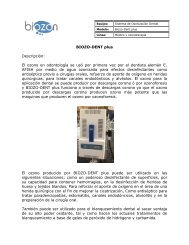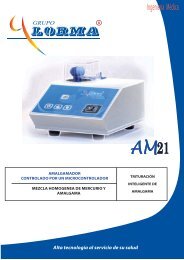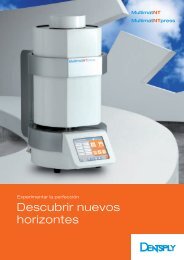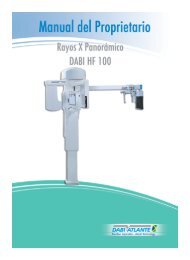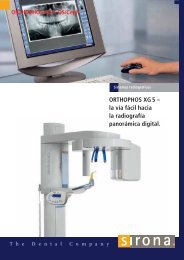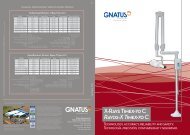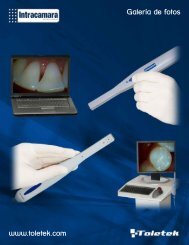Injections are now easier and safer to give. - promosa dental
Injections are now easier and safer to give. - promosa dental
Injections are now easier and safer to give. - promosa dental
Create successful ePaper yourself
Turn your PDF publications into a flip-book with our unique Google optimized e-Paper software.
Easier.Safer.All proceduresmade easy.With the CompuDent system,all injections, even palatals, becomemore comfortable, predictable,<strong>and</strong> controllable. You can easilyperform these injections:• anterior middle superioralveolar block (AMSA)• palatal anterior superioralveolar block(P-ASA)• periodontal ligament injection (PDL)• inferior alveolar block• supraperiosteal infiltration• nasal pallatineEasier <strong>to</strong> h<strong>and</strong>leWith the microprocessor-controlled CompuDent deliverysystem <strong>and</strong> one of the unique W<strong>and</strong> ® h<strong>and</strong>pieces, givinglocal anesthetic injections of all types has never been <strong>easier</strong>.Because the flow rate of the anesthetic is controlled by amicroprocessor instead of the pressure of your thumb, it ismore precise. The system can make giving an injection oneof the easiest tasks in your busy day.Easier on your h<strong>and</strong>sThe CompuDent system is ergonomically designed <strong>to</strong>reduce muscle fatigue comp<strong>are</strong>d with a traditional syringe. 1This is because the force required <strong>to</strong> deliver anestheticsolution in<strong>to</strong> tissue is virtually eliminated, even in<strong>to</strong> thetissue of the palate. Less fatigue lets you be moreproductive <strong>and</strong> feel better at the end of the day.Easier on your patients,so they’re <strong>easier</strong> on youMany patients believe that needle insertion is whatcauses discomfort during an injection, when in fact mos<strong>to</strong>f the pain is caused by the flow of the anesthetic. TheCompuDent has three specific flow rate including ControlFlo<strong>and</strong> RapidFlo, that result in an injection experience that hasproven <strong>to</strong> be far more comfortable than with a traditionalsyringe. And <strong>now</strong>, certain injections can be delivered moreaccurately <strong>and</strong> comfortably in the same time it takes witha traditional syringe, with new TurboFlo. This makes the<strong>dental</strong> experience more positive for the patient, which isless stressful for you <strong>and</strong> your staff. And providing gentlerdentistry can help <strong>give</strong> your practice a competitive edge.1. Murphy, DC, ed. Ergonomics <strong>and</strong> the Dental C<strong>are</strong> Worker, p. 181.Washing<strong>to</strong>n DC: American Public Health Association; 1998.2. Hochman M., DDS; Chi<strong>are</strong>llo D., DDS; Hochman C., DDS; Lopatkin R., DDS;Pergola S., DDS. Computerized Local Anesthetic Delivery vs. Traditional SyringeTechnique. New York State Dental Journal, August/September 19973. www.osha.gov/SLTC/bloodborne pathogens/index.html4. Hochman M, Friedman M. In vitro study of needle deflection:A linear insertion technique versus a bi-directional rotationinsertion technique. Quintessence Int 2000;31(1):33-39.5. Safer Needle Devices: Protecting Healthc<strong>are</strong> Workers, Occupational Safety<strong>and</strong> Health Administration, Direc<strong>to</strong>rate of Technical Support, Office ofOccupational Health Nursing, Oc<strong>to</strong>ber 19976. ADA News, Oc<strong>to</strong>ber 6th, 2003. volume 34. Number 18.You maynever missanotherblockinjectionAs the needle is inserted,anesthetic is deliveredin a constant computercontrolledmannerregardless of tissuedensity.CompuDent’sprecise flow ratedevelops an anestheticpathway,allowing a morecontrolled penetrationof the needlethrough tissue.With a traditionalsyringe, the staticposition of theneedle relative<strong>to</strong> the beveledend causesdeflection.A missedblock or delayedonset can result.The back <strong>and</strong> forth 180°bi-directional rotationcontinually changes theneedle bevel positionthereby defeatingneedle deflection, allowingthe needle <strong>to</strong> trackstraight <strong>to</strong> the target.Traditional InsertionBi-directionalRotational InsertionSafetyW<strong>and</strong> is the revolutionary answer <strong>to</strong> the federallegislation requiring safety engineered devices fordentists. The unique au<strong>to</strong>-retracting design shieldsthe needle while you’re not using it.SafetyW<strong>and</strong> is <strong>safer</strong> <strong>and</strong> lighter than a traditional syringe<strong>and</strong> is operated with one h<strong>and</strong>, which is required underthe Federal Needlestick Safety Act 3 .Safer for you, your staff …<strong>and</strong> your practiceThink of the palm-thumb grasp <strong>and</strong> pressingmovement required <strong>to</strong> inject with a traditional syringe.Then picture the precise movements you can makewhen holding a pen – <strong>to</strong> write, <strong>to</strong> draw. No wonder theSafetyW<strong>and</strong> enables such accuracy. The pen-like graspallows bi-directional rotation during an injection, whichprevents needle deflection that occurs with a traditionalsyringe. 4 A straighter path results in a more accurateinjection, meaning fewer missed blocks, <strong>and</strong> a morerapid onset of anesthesia.Better safe than sorryThe SafetyW<strong>and</strong> was developed <strong>to</strong> address requirementsof the Federal Needlestick Safety Act, m<strong>and</strong>atingthe use of a safety engineered sharps device <strong>to</strong> eliminateinadvertent needle sticks. The Act was adopted after itwas found that U.S. healthc<strong>are</strong> workers suffer from anestimated 800,000 5 needle-stick injuries each year, someof which resulted in cases of HIV, Hepatitis B, Hepatitis C<strong>and</strong> other illnesses.The SafetyW<strong>and</strong> is the first patented safety engineereddevice that is fully compliant with more than 30 parameterspublished by OSHA while also meeting the clinicalneeds of <strong>dental</strong> practitioners. It provides the practitionerwith a <strong>safer</strong>, retractable needle device, with single h<strong>and</strong>activation, which is reusable multiple times during a singlepatient visit, yet small <strong>and</strong> sleek enough not <strong>to</strong> obscurethe dentist’s often limited field of view.Why should I comply?– excerpted from the ADA News,Oc<strong>to</strong>ber 6th, 2003. volume 34. Number 18.“CDC guidelines do not, by themselves, have theforce of law. However, many states do incorporateCDC recommendations by reference in<strong>to</strong> state law.Other states look <strong>to</strong> CDC guidelines in interpretingstate law. Accordingly, in some states, compliancewith the CDC guidelines is, at least as a practicalmatter, m<strong>and</strong>a<strong>to</strong>ry. Even in states with no explicit orimplicit requirement <strong>to</strong> comply with CDC guidance,dentists should seriously review the new guidelines.In any malpractice lawsuit, the CDC guidelineswill likely be looked at as a source for a st<strong>and</strong>ard ofc<strong>are</strong> the dentist is expected <strong>to</strong> meet. Further, <strong>to</strong> theextent the guidelines protect against occupationalhazards, as opposed <strong>to</strong> hazards <strong>to</strong> the patients,OSHA may review these guidelines as a basis forasserting a claim that a dentist is not meeting hisor her “general duty” <strong>to</strong> provide a workplace freefrom recognized hazards. 6 ”The needle is retracted when not in use.



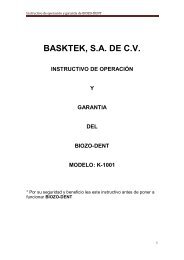
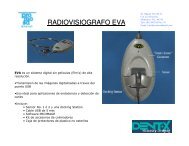
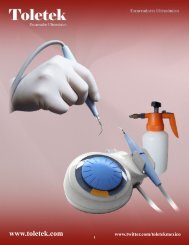

![Articulador Gnatus jp30 [Read-Only] [Compatibility ... - promosa dental](https://img.yumpu.com/47474132/1/190x134/articulador-gnatus-jp30-read-only-compatibility-promosa-dental.jpg?quality=85)
